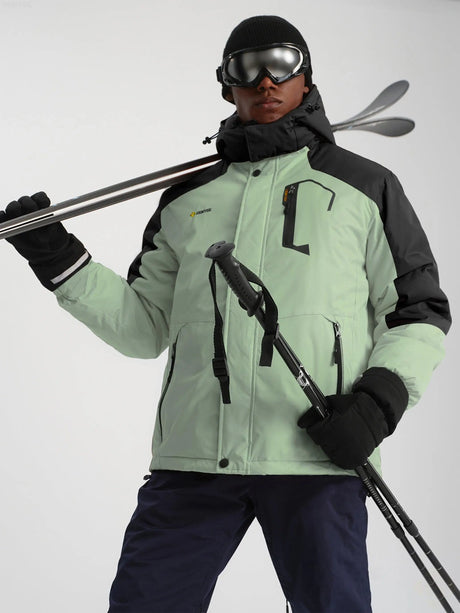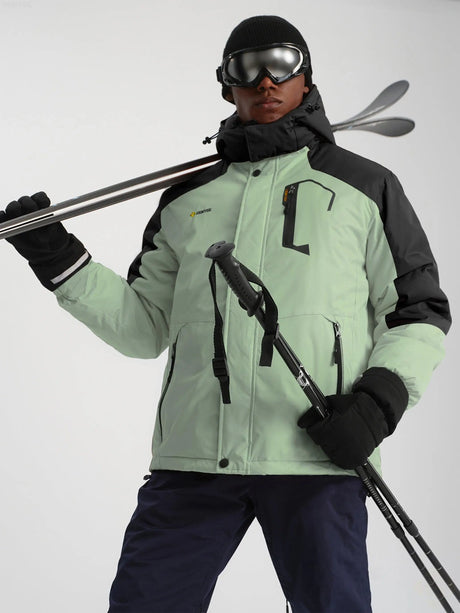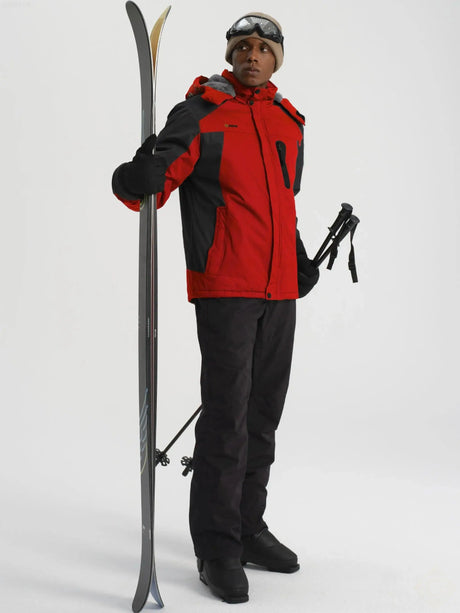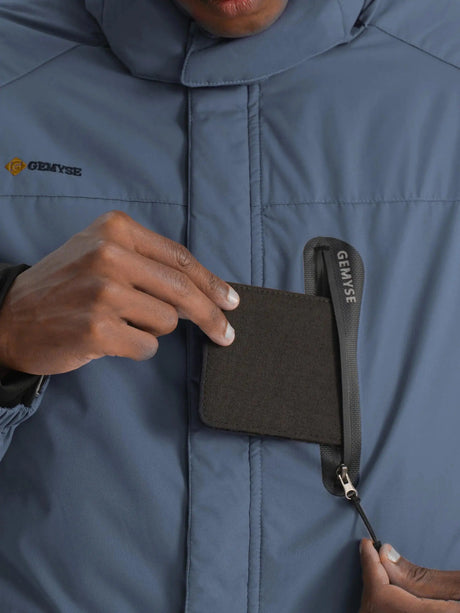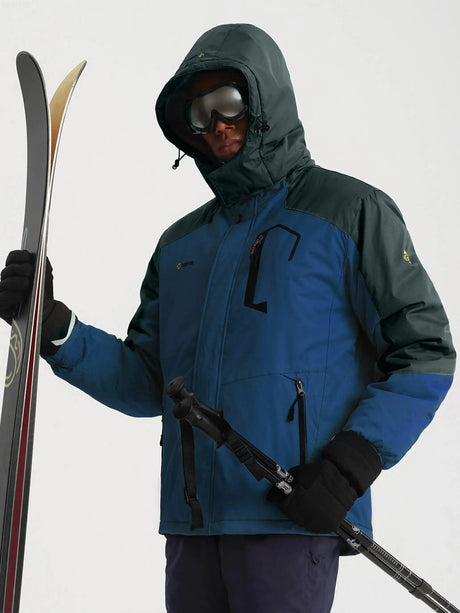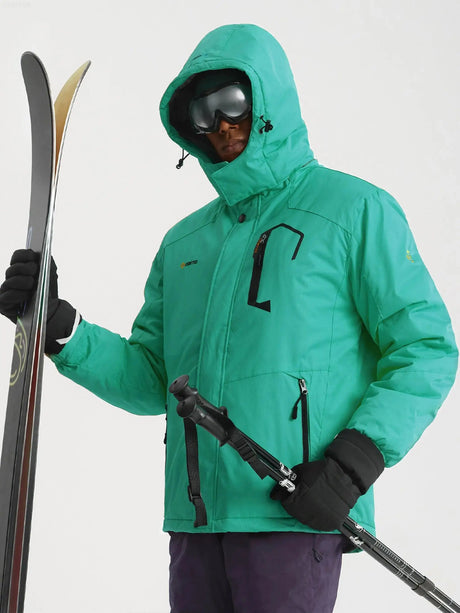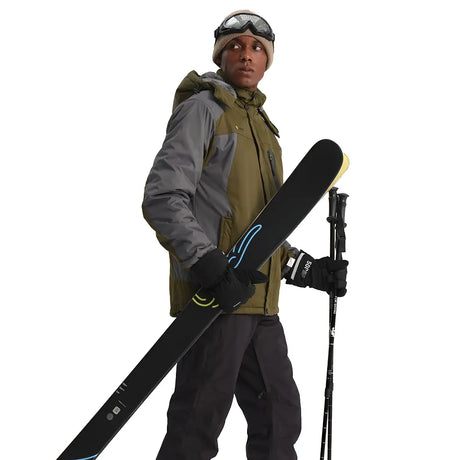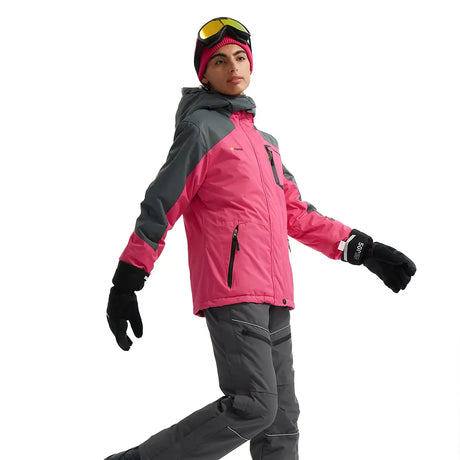Choosing the Best Lightweight Ski Jacket
Choosing the right ski jacket is crucial for a great skiing experience. A lightweight ski jacket offers warmth without the bulk.
These jackets are perfect for active skiers who need flexibility. They allow for easy movement on the slopes.
Lightweight ski jackets come with various features. Many have snow skirts, adjustable hoods, and multiple pockets.
Waterproofing is a key feature. It keeps you dry in wet snow conditions. Look for jackets with high waterproof ratings.
In Canada, ski coats are designed for extreme cold. They often feature advanced insulation technologies.
A ski jacket with a removable liner offers versatility. You can adjust it for different weather conditions.
The style of your ski jacket matters too. Black ski tops are versatile and pair well with various ski pants.
Choosing the best lightweight ski jacket involves considering fit, insulation, and style.
Why Choose a Lightweight Ski Jacket?
Lightweight ski jackets offer several advantages. They provide warmth while maintaining a slim profile. This design allows for easy movement.
Active skiers benefit from the flexibility these jackets offer. Whether turning sharply or navigating challenging terrains, lightweight ski jackets enhance mobility.
Moreover, these jackets are perfect for layering. A thin base layer can easily fit beneath them. This versatility helps you adapt to varying conditions.
Lightweight ski jackets can include features like:
- High-quality waterproofing
- Breathable materials
- Adjustable hoods
These features ensure comfort during skiing. The lightweight nature of these jackets also makes packing a breeze. They fit snugly in your travel bag.
Choosing a lightweight ski jacket means choosing comfort and flexibility. For skiers valuing performance and ease, these jackets are ideal.
Key Features of a Lightweight Ski Jacket
Lightweight ski jackets are more than just simple winter apparel. They combine modern technology with sleek design to offer skiers the best experience.
One key feature is superior insulation. Despite their light nature, these jackets retain heat effectively. You stay warm on the coldest days without extra bulk.
Waterproofing is another standout feature. Snowy conditions demand a jacket that can repel moisture. A high waterproof rating ensures you remain dry and comfortable.
Breathability is crucial for dynamic ski days. Ensuring good airflow prevents overheating. This enhances overall comfort during intense activities.
Ski jackets often come with additional features:
- Adjustable cuffs
- Helmet-compatible hoods
- Multiple storage pockets
These features add convenience and functionality. When skiing or snowboarding, having everything easily accessible matters.
Lastly, the fit of these jackets is worth noting. They are designed to be both snug and adaptable. This balance supports movement and layering.
Insulation: Warmth Without Bulk
When choosing a ski jacket, insulation is paramount. Lightweight ski jackets master providing warmth without the heaviness.
Modern insulation materials keep the weight low. Options like synthetic fibers and down provide superior warmth. Each choice has its advantages in various conditions.
A lightweight ski jacket excels due to its slim design. This design ensures you stay agile on the slopes. No bulk means more freedom to move.
Key insulation features include:
- Synthetic insulation: lightweight and water-resistant
- Down insulation: provides excellent warmth
- Thinsulate™ technology: efficient heat retention
Each type suits different needs. Consider your skiing environment before deciding.

Waterproofing and Breathability
Effective waterproofing in ski jackets cannot be overstated. Staying dry is essential in snowy, wet conditions. Jackets with a high waterproof rating excel in adverse weather.
Breathability is just as important. It ensures that sweat and moisture escape. This prevents that uncomfortable damp feeling during activity.
Many ski jackets offer combination materials. These materials deliver both waterproof qualities and breathability. Balancing these features improves comfort.
Look for:
- Taped seams to block out moisture
- Waterproof zippers
- Fabrics with breathability ratings
Each item ensures you remain warm and dry. A truly waterproof ski jacket should not compromise on breathability.

Fit and Comfort: Slim, Long, and Layer-Friendly
The fit of a ski jacket greatly influences its performance. Lightweight ski jackets are crafted to be slim yet comfortable.
A well-fitted jacket enhances movement on the slopes. Skiers can maneuver freely without restrictions. It also allows for effective layering beneath the jacket.
Consider the jacket's cut and style. Some prefer a long cut for added warmth. Long jackets provide extra coverage against wind and snow.
Key fit features include:
- Slim fit: Sleek design, less bulk
- Long cut: More protection against elements
- Adjustable features: Personalized fit
Every skier has unique needs. Make sure your jacket's fit aligns with your style and comfort.

Versatility: Removable Liners and Multi-Use Designs
Versatility is a hallmark of modern ski jackets. Features like removable liners add to their adaptability.
A jacket with a removable liner offers flexibility. You can adjust it according to the weather. On warmer days, shed the liner and keep it light.
Multi-use designs are gaining popularity. These designs let the jacket perform in various conditions. A multi-functional ski jacket is a valuable investment.
Versatile features may include:
- Removable hood
- Detachable inner lining
- Convertible elements for different uses
This versatility ensures your jacket serves you year-round. Whether for skiing or casual wear, the right jacket fits all occasions.

Comparing Lightweight Ski Jackets: Types and Styles
Choosing the right lightweight ski jacket involves considering different types and styles. Each style offers distinct benefits that cater to specific needs on the slopes.
Thin ski coats emphasize freedom of movement. These jackets are ideal for active skiers who prioritize flexibility. They may lack the insulation found in heavier jackets but make up for it with their lightweight build.
Insulated ski jackets provide warmth necessary for colder climates. They strike a balance between warmth and weight. Insulated jackets often incorporate advanced materials to trap body heat while maintaining a streamlined shape.
Styles range from traditional to trendy. Your choice depends on personal preference and specific skiing conditions. Many ski enthusiasts prefer jackets with practical features that cater to long days in the snow.
Here are key style elements to consider:
- Various color schemes and patterns
- Features like hoods and multiple pockets
- Distinct fits, such as slim or long cuts
The aesthetic appeal of a jacket is just as important. Choose a style that aligns with your visual preferences.

Thin Ski Coats vs. Insulated Ski Jackets
Thin ski coats and insulated ski jackets serve different purposes. Understanding these differences helps in making an informed choice.
Thin ski coats focus on mobility and lightness. They're crafted for energetic skiing or milder conditions. These coats typically feature minimal insulation, relying on layers for warmth.
Insulated ski jackets are designed for cold temperatures. They incorporate materials like down or synthetic fibers. This provides better heat retention while remaining relatively lightweight.
Consider these factors when choosing between the two:
- Weather conditions you plan to ski in
- The level of activity you engage in
- Whether you prioritize warmth or flexibility
Choosing the right style hinges on balancing these aspects. Always prioritize your comfort and skiing style.

Slim Fit, Long, and Black Ski Tops: Style Choices
Ski jacket styles reflect personal taste and functional needs. Slim fit, long, and black ski tops cater to varied preferences.
Slim fit ski jackets appeal to those who favor a tailored look. These jackets cling to the body's contours. They offer warmth without adding bulk.
Long ski jackets are popular for added protection. They cover more of your body, shielding you from harsh winds and cold snow.
Black ski tops are versatile and stylish. They pair easily with any ski outfit or gear. This timeless look stands out without being overwhelming.
Key considerations:
- Slim fit for a sleek, modern appearance
- Long jackets for extended coverage
- Black tops for classic elegance
Understanding these style choices aids in selecting a jacket that suits both your style and functional needs.

Top Features to Look For When You Buy a Ski Jacket
Selecting a ski jacket involves evaluating several key features. These elements ensure that your jacket provides optimal performance on the slopes.
First, waterproofing is essential for staying dry in wet conditions. Look for jackets with high waterproof ratings. Materials like Gore-Tex offer excellent protection against moisture.
Breathability is equally crucial. A breathable jacket helps regulate body temperature during intense activities. Ventilation features, like pit zips, enhance airflow.
Insulation type affects warmth and comfort. Down insulation provides excellent warmth-to-weight ratio. Synthetic materials, however, perform better in wet conditions.
Consider the jacket's fit and adjustability. Features such as adjustable cuffs and hems ensure a snug fit. This prevents snow from entering and enhances mobility.
Additional features add convenience:
- Multiple pockets for storing essentials
- Helmet-compatible hoods for added safety
- Integrated snow skirts to keep out snow
Durability should not be overlooked. High-quality construction and reinforced areas ensure your jacket withstands rugged conditions. A durable jacket offers long-lasting value.
Finally, consider the jacket’s style and color. While functionality is key, aesthetic appeal matters too. Choose a design that reflects your personal style.

Lightweight Ski Jackets for Different Conditions
Different skiing conditions demand specific features in a ski jacket. Choosing the right type can enhance your comfort and safety on the slopes.
Lightweight ski jackets are versatile, accommodating various weather scenarios. They are suitable for both harsh winters and milder spring conditions, offering the flexibility needed for changing environments.
For cold regions, ski jackets should feature advanced insulation. Ensure they can trap heat effectively while minimizing bulk. Look for materials known for exceptional warmth retention.
In wet and unpredictable weather, waterproofing becomes critical. Jackets with fully taped seams provide excellent protection against moisture. Breathability is equally important to prevent overheating.
Consider versatile designs for changing conditions:
- Jackets with removable liners
- Convertible designs for different weather
- Integrated ventilation systems
Ultimately, the goal is to adapt to any weather seamlessly. A well-chosen ski jacket will serve you well in diverse climates, ensuring optimal performance and enjoyment.

Ski Jackets for Canada and Extreme Cold
Canadian winters are notoriously frigid, demanding exceptional gear. Ski jackets for such climates prioritize warmth and protection against extreme cold.
Insulation is pivotal here. Look for jackets filled with high-quality down or advanced synthetic materials. These provide warmth without excessive weight.
In extreme cold, additional features enhance comfort and protection. A ski jacket with a high collar and adjustable hood offers added defense against winds. Cuffs and hems should be snug to seal out the cold.
Vital features include:
- Advanced insulation for maximum warmth
- Windproof materials to block chilling gusts
- Adjustable hoods for added head protection
Choosing the right ski jacket for Canadian conditions ensures you stay warm. In harsh environments, having reliable ski outerwear is a game-changer.

Spring Skiing and Mild Weather Options
Spring skiing offers milder weather and unique challenges. Lightweight ski jackets for these conditions focus on flexibility and breathability.
Opt for jackets with light insulation and superior ventilation. Look for those with adjustable vents and breathable fabrics to manage body heat.
Ideal features for spring skiing:
- Enhanced breathability for temperature regulation
- Lightweight construction for easy movement
- Weather-resistant but not heavily insulated
Selecting the right jacket for spring ensures comfort and freedom. Light and breathable options let you enjoy the slopes without overheating.

How to Choose the Right Lightweight Ski Jacket for You
Choosing the right lightweight ski jacket involves considering your specific needs and skiing style. Start by assessing the typical weather conditions you face.
Identify the primary function of your jacket. Is it for resort skiing, backcountry adventures, or casual wear? Your activities will guide your choice in features.
Focus on fit and comfort as well. Make sure the jacket allows for layering without restricting movement. Try different fits, like slim or regular, to find what feels best.
Key elements to consider include:
- Insulation appropriate for your climate
- Waterproof and breathable fabric for moisture management
- Suitable features like hoods and snow skirts
Budget also plays a vital role. Define a range that accommodates the features you deem non-negotiable. Balance quality with affordability to maximize value.
Ultimately, a well-chosen ski jacket complements your skiing experiences. It offers comfort, protection, and style, enhancing your time on the slopes.

Care, Maintenance, and Durability Tips
Caring for your lightweight ski jacket properly extends its life and maintains performance. Regular maintenance is key to ensuring your jacket serves you for many seasons.
Start by following the manufacturer’s care instructions. These guidelines are tailored to the jacket's materials and construction. Most ski jackets benefit from gentle washing with mild detergent. Avoid fabric softeners as they can impact waterproofing.
- Use a gentle cycle for washing
- Hang dry or tumble dry on low if advised
- Store in a cool, dry place
Regularly inspect your jacket for damage. Check seams, zippers, and fabric for wear. Repair small tears promptly to prevent them from growing. Reapply waterproofing treatments when water no longer beads up on the surface.
By following these tips, your jacket will remain functional and stylish. A little care goes a long way in preserving its durability.

Frequently Asked Questions About Lightweight Ski Jackets
When choosing a lightweight ski jacket, common questions arise. Addressing these can help in making a confident purchase.
Are lightweight ski jackets warm enough?
Yes, they are designed to offer warmth while minimizing bulk. Advanced insulation technology ensures comfort even in cold conditions.
How do I know if a jacket is waterproof?
Look for jackets with waterproof ratings. High ratings (e.g., 10,000mm or more) indicate strong protection against moisture.
What features enhance a jacket’s comfort?
Comfort features include adjustable cuffs, hoods, and ventilation options. Ensure the fit allows for ease of movement.
- Warmth with minimal bulk
- High waterproof ratings
- Comfort-enhancing features
Are lightweight jackets suitable for layering? Absolutely, they work well with base and mid-layers for customizable warmth.
By understanding these aspects, you can find a ski jacket that fits your needs seamlessly. A well-chosen jacket enhances your skiing experience significantly.
Conclusion: Find Your Perfect Lightweight Ski Jacket
Choosing the right lightweight ski jacket can enhance your skiing experience. It ensures comfort, warmth, and protection in different conditions. With the right features, you enjoy more time on the slopes without discomfort.
Remember to prioritize key factors like fit, insulation, and waterproofing. A well-thought-out choice will keep you warm and dry all season long. By understanding your needs and using this guide, you can find the perfect ski jacket. Enjoy the slopes with confidence and style.

